
Someone—a student, employee, colleague, or friend—has asked you to write them a letter of referral to help them land a new position or a spot at an academic institution.
You’re happy to help, but... you really don’t want to mess it up!
Don’t stress. You can do this and do it well, and it doesn’t have to take hours of your time.
What Is a Referral Letter?
A referral letter, or letter of recommendation, is often required with job or school applications.
It’s a document written by someone who has a relationship with the applicant, and who can attest to the skills and characteristics that make them a great choice for a professional position or an academic institution.
While a resume or a transcript provides work or academic history, a referral letter gives a more personalized account of the candidate’s qualities, work ethic, and skills.
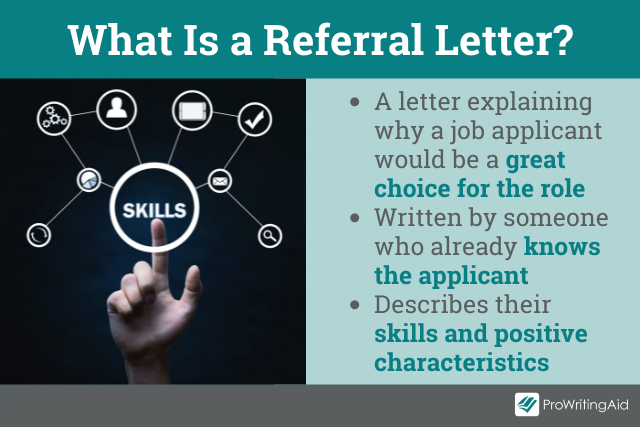
Additionally, the referral letter provides support and verification of the applicant’s claims about themselves from an outside source. It is also an opportunity to add more substance to those claims using examples and personal experiences.
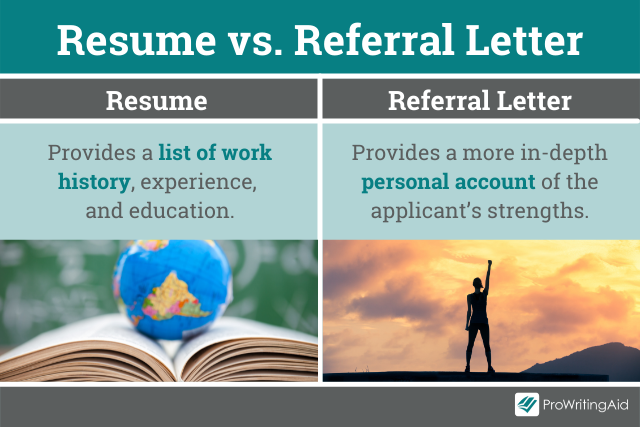
What Makes a Strong Referral Letter?
Referral letters should be:
Honest
A referral letter should never be padded with exaggerated or false information. If you can’t write an honest letter of recommendation for someone, politely decline their request.
For one, the dishonesty is simply unethical and unprofessional. Second, the dishonesty will probably come to light during interviews. Or it might become obvious later, after the applicant is hired or enrolled and can’t live up to their own hype, which you helped embellish!

Either way, that exposed dishonesty is a blow to your integrity and reputation.
Believable
Even if you are “over the moon” about helping the applicant, and you think the person is the “absolute best ............” you’ve ever known, keep your tone and enthusiasm controlled.
Avoid hyperbole, and use adjectives purposefully.
Non-specific adjectives that offer high praise but little substance aren’t particularly helpful in convincing the letter’s recipient that the candidate is their best choice.

For example, “fantastic worker” or “awesome student” is high praise that doesn’t zero in on specific qualities that will convince the recipient that the applicant is their best choice.
Personal
Using a template to structure your letter and determine your content is a good idea. You’ll save time and the template will help ensure that your letter is organized and thorough.
However, the details of the letter’s content—the specific examples—should be obviously connected to the person you’re supporting.
You need to do more than swap out the name of the applicant each time you write a letter.
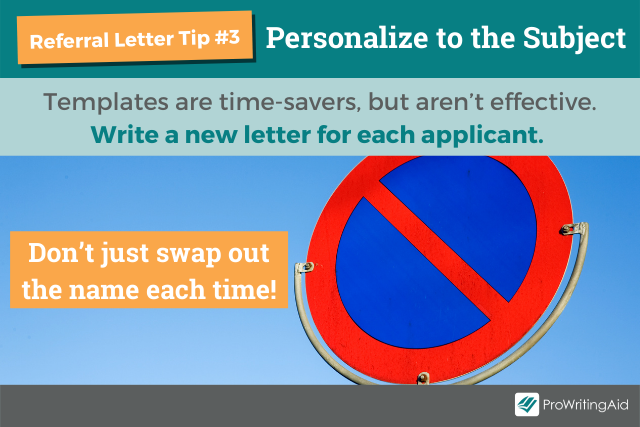
Well-written
Take the time to edit and proofread your letter carefully. Read it out loud. Run it through ProWritingAid’s Realtime Report.
For a person to take your recommendation seriously, you want to represent yourself as a credible source of information on behalf of the candidate.
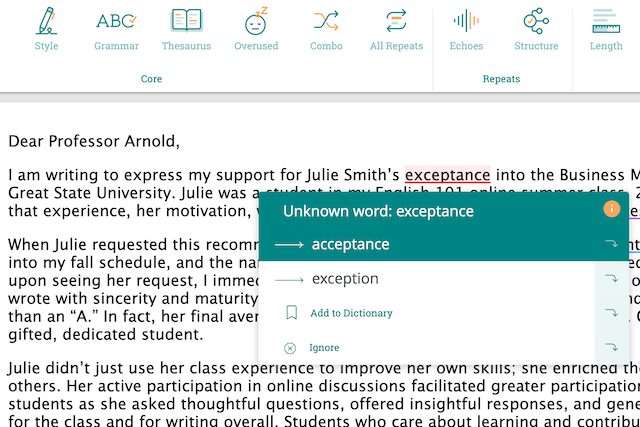
How Do I Prepare to Write a Referral Letter?
You don’t have to complete these steps in this exact order; you just need to complete them!
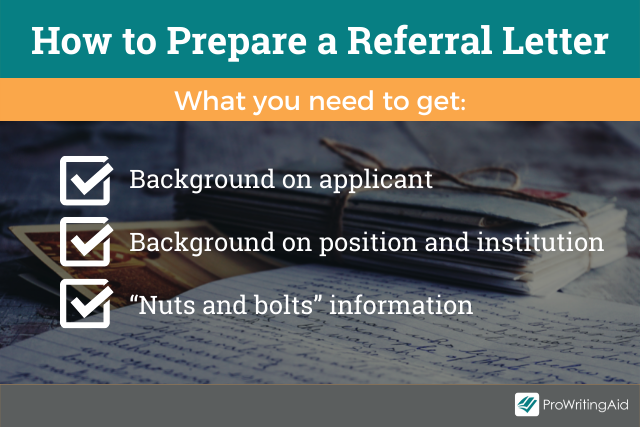
1. Gather Background on the Workplace
Learn about the company and position or academic program and university the applicant is pursuing.
A quick perusal of the website and its “about” page should do the trick. Most of your information, though, should come from the applicant; you should not have to do extensive research.
Ask the applicant for an overview of the company or institution and why “this” is the place they want to work / attend.
Ask for a few specifics about the position or academic program.
Using this information, you’ll be able to tailor your comments about the applicant to the ethos of the company or school, and highlight the qualities that make them a good match.

2. Gather Background on the Applicant
You shouldn’t have to dig too deep for this information.
The fact that the applicant has asked you for a recommendation means that you have a relationship with them and have either worked with them, taught or mentored them, or served on committees with them.
However, you still might need to enrich that information.
Ask the candidate for a brief list or summary of special projects, extra-curricular activities, or achievements / awards they have participated in or earned.
If you’re writing for a student application, review the student’s transcript so you can write honestly about their academic achievement.
If they didn’t start out strong, but showed growth and maturity as they progressed through high school or a two-year college, you can attest to that development.
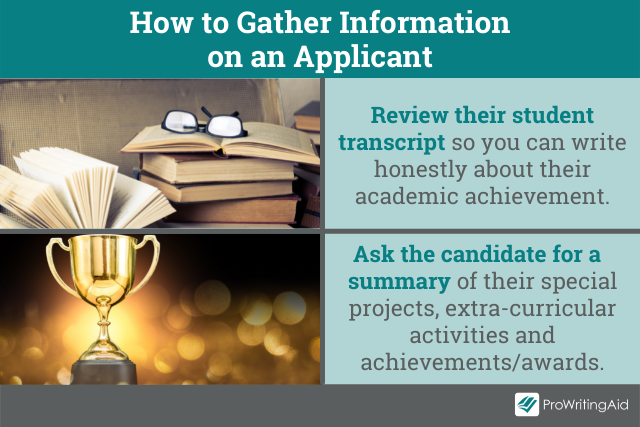
3. Gather the Nuts and Bolts Information
Be certain to address your letter to the correct office and recipient. Again, the applicant can help you here.
Ask for exact names and contact information, and find out if the recipient prefers the letter in a specific format (e.g. Word Doc, Google Doc, PDF).
What Information Should a Referral Letter Have?
Though you should tailor each reference letter you write for the person you’re supporting, there are certain elements every letter should have.
1. Your contact information
If you have a letterhead, this information is already there. If you don’t, be certain to include your name, title, and contact details in an appropriate format on the letter.
Some prefer to put this information at the top of the letter, flush with the left margin, others put it after their signature. Whatever format you choose, make sure the information is easily accessible.
2. The recipient’s name, title, and address in an appropriate format
Including this information makes it easy to route the letter to the correct person.
For example, an administrative assistant may be the one to receive and sort letters, so making their final destination clear is helpful to all involved.
3. A specific salutation
“To whom it may concern” is not the way to start a convincing letter. Instead, address the actual person, people, or team receiving the letter.
- Dear Ms. Williams
- Dear President Smith
- Dear Mr. Jones
- Dear Mx. Brown
- Dear Dr. Sullivan
- Dear Chairperson White and Members of the Admissions Committee
- Dear [first and last name]
4. A brief introduction
Establish both your purpose for writing and your credibility as a source of information about the applicant.
5. A discussion of the applicant’s work or performance
Highlight specific achievements with examples or anecdotes.
6. An explanation of how the candidate is a standout
What elements of their character or performance make this person shine? How did those characteristics serve to elevate those around them?
7. Connections between the applicant’s achievements, performance, and characteristics and their future situation
How will the candidate’s future colleagues, bosses, classmates, organization, or institution benefit from what the candidate has shown they have to offer? You can make these connections as you write about the applicant’s performance and standout qualities.
8. A final comment about your belief in the candidate
Express the confidence you have in the contents of your recommendation and in the candidate, and offer an invitation for the recipient to contact you with any follow-up questions.

What Is a Good Template for a Referral Letter?
This example represents the qualities of a strong letter and the contents of a thorough letter.
Though it is an academic recommendation, the same format can be used for a professional letter, with work performance and qualities replacing the academic examples.
While templates can help you structure and organize your letter, you’ll still need to consider and adjust some of the finer details as per the applicant’s request (e.g. how will you refer to the applicant?).
Remember to gather background and “nuts and bolts” information before you write your referral letter.
May 10, 2021
Professor Beth Simms
Department of English
Community College
One College Road
Garden Park, State 11111
Professor Joseph Arnold
Business/Business Marketing Program
Great State University
Two College Road
Park City, State 22222
Dear (Professor Arnold),
(Introduction: establish relationship and credibility)
I am writing to express my support for (Julie Smith’s) acceptance into the (Business Marketing Program at Great State University). (Julie) was a student in my (English 101 online summer class, 2020), and based on that experience, I can attest to her motivation, work ethic, and academic achievement.
(Personalized discussion of applicant’s performance/connections to in)
When (Julie) requested this recommendation, our class had been over for three months, I was halfway into my fall schedule, and the names of all of my current students had already filled my brain. Still, upon seeing her request, I immediately recognized her name and recalled several of her essays. She wrote with sincerity and maturity. Her work was always submitted on time (truly) and never earned less than an “A.” In fact, her final average was a 97% and her cumulative GPA is a 3.97. Clearly, she is a gifted, dedicated student.
(Discussion of a distinct, standout quality/connection)
(Julie) didn’t just use her class experience to improve her own skills; she enriched the experiences of others. Her active participation in online discussions facilitated greater participation from other students as she asked thoughtful questions, offered insightful responses, and generated enthusiasm for the class and for writing overall. Students who care about learning and contribute to an atmosphere of engagement and scholarship in their classrooms, as (Julie) did, facilitate a learning environment and experience that is better for everyone involved.
(Additional discussion of distinctive qualities/connection)
Through her work, (Julie) shared her decision to take time away from school to determine her career path. She has shown true initiative, using that time to acquire “real-world” experience, and taking on her current leadership role as marketing coordinator for (Sell This!). (Julie) has evaluated this experience, gaining insights about her specific strengths and interests in the field which have prompted her to apply for (Great State’s) program. I am certain that (Julie) will complete the course of study successfully and apply the skills she acquires to her present and future real-world experiences. She will be an impressive representative of your program.
(Final comment expressing confidence/invitation to speak further)
It is with pleasure that I recommend (Julie Smith) for (Great State’s Business Marketing) program. I am confident in her ability to complete the program successfully, to elevate the experiences of her peers, and ultimately, to represent (Great State) admirably. Please contact me at (phone and email) if you would like to discuss this recommendation further.
Sincerely,
(Professor Beth Simms)
Email
Phone
How Do Referral Letters Help Applicants?
Referral letters provide personal information to help back up the claims applicants make on their CVs and cover letters. They help tell the story of why they are perfect for the role they are applying for.
So remember, only write a letter of recommendation if you genuinely believe in the applicant and their suitability for the opportunity at hand.
Now you have these tips and templates, the next time you’re asked to write a referral letter, you don’t have to stress about how to “get it right.”
Gather your information, fill each component, and provide personal, honest support for your colleague (or employee, or student). You’ve got this!


